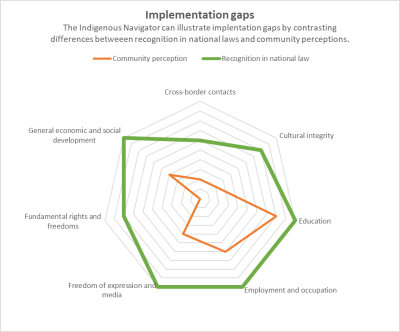Indigenous Navigator Index: Visualising rights on the ground
The Indigenous Navigator Community Index and the Indigenous Navigator National Index are tools that serve to rank countries’ performance with regard to recognizing and implementing indigenous peoples’ rights.
The Indigenous Navigator Community Index and the Indigenous Navigator National Index are tools that serve to rank countries’ performance with regard to recognizing and implementing indigenous peoples’ rights.This means: are laws, policies and government programmes in line with the UNDRIP? And what is the situation on the ground – are indigenous peoples’ rights respected and realized in practice?
The index tool allows easy graphic visualisation of scores and ranks to complement gap analysis, reporting, and comparisons across regions, countries and communities.
The Indigenous Navigator Index was designed to monitor 12 essential domains of indigenous peoples’ rights.
Within each of the 12 essential domains of rights included in the short questionnaires, a few questions have been selected as key markers of a country’s performance in terms of recognition and implementation of indigenous peoples’ rights within that particular domain.
By assigning a numerical value to key questions within each of the 12 domains assessed in the Short Community Questionnaire and the Short National Questionnaires respectively, the performance is scored, whereby it becomes comparable and also easy to illustrate in a graphic form, which can be communicated easily to all kinds of actors.
The Indexes are ranking tools that summarize a country’s performance in a score - or present them graphically:

The outer part of the spider web represents a high score, indicating a high level of recognition/realization of indigenous peoples’ rights, while the centre represents a low score. In the example included above, the two domains of “Recognition of identity/participation and “Employment, occupations and poverty” are scoring 10 points (maximum score), while the domains of “Education and “Fundamental rights and freedoms” are scoring only 1 point.
Assessing the vitality of indigenous languages
For example, article 13 of the UNDRIP states that indigenous peoples have the right to revitalize, use, develop and transmit to future generations their languages.
By using the Index Tool, indigenous communities can assess the vitality of their language on a scale from 0-10 (extinct to safe).
If an indigenous language is “safe”, spoken by all generations with an uninterrupted intergenerational transmission, the answer to the question will get the highest score of 10. If the language is extinct it will score 0. This situation can then be compared with national initiatives and laws on indigenous languages, which will also result in a score between 0 and 10.
For the assessment of language endangerment, we have used UNESCO criteria, which takes into consideration if the indigenous languages are recognized as official languages in the country and if it is used in systems of signposting, documentation and official communications.
Comparing Index Values

When an Indigenous Navigator Community Index and an Indigenous Navigator National Index have both been generated in the same country, a comparison of the two will show whether communities’ experiences with actual respect for their rights reflect the level of recognition of their rights in national legislation, policies, and programmes:
Likewise, Index Values can be compared across communities, across countries – or data from the same community or country can be compared over time if data gathering is repeated.
You can get more information on the technical details by contacting Stinne Skriver Jørgensen on stjo@humanrights.dk or Omar Layachi on omla@humanrights.dk